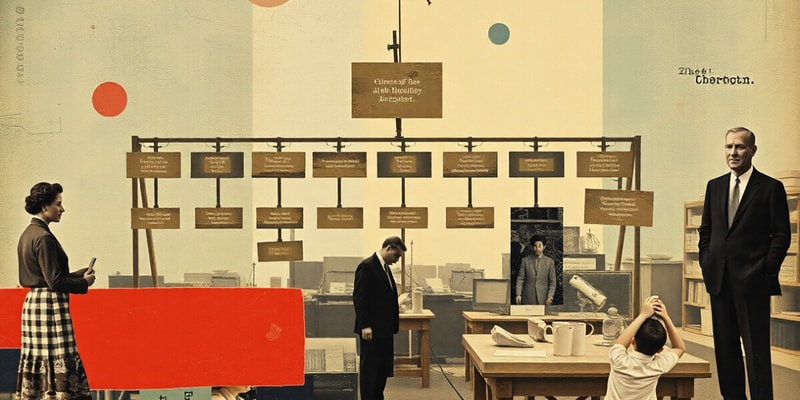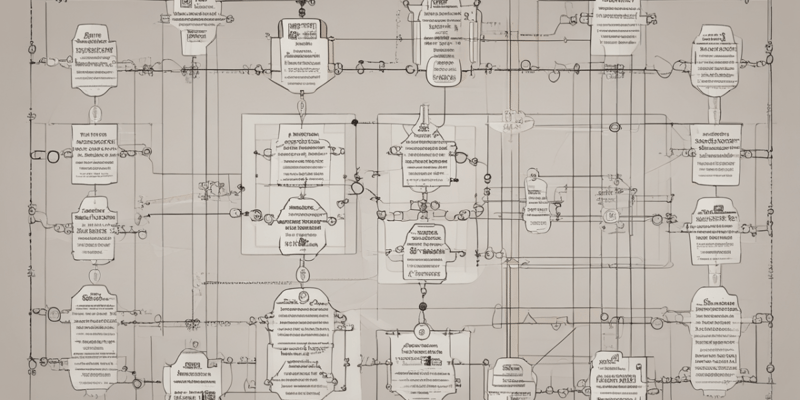Podcast
Questions and Answers
What is the primary purpose of organisational structure within a business?
Which of the following best describes the term 'spans of control'?
Which aspect of structural configuration impacts the quality of employee motivation?
What is meant by a 'flat structure' in an organisation?
Signup and view all the answers
How is the process of organisational task division and coordination best achieved?
Signup and view all the answers
What is a significant disadvantage of functional structuring within an organization?
Signup and view all the answers
What is an advantage of organizing a company by product/service?
Signup and view all the answers
Which disadvantage is associated with geographical structuring in multinational corporations?
Signup and view all the answers
What is a potential drawback of a company adopting a mixed organizational structure?
Signup and view all the answers
What is a disadvantage unique to functional departmentalization?
Signup and view all the answers
Study Notes
Organizing
- The process of dividing tasks to achieve organizational goals.
- Reflect on plans and objectives.
- Establish major tasks.
- Divide major tasks and allocate resources.
- Evaluate outcomes and make necessary changes.
Organizational Structure
- The pattern of how activities are divided and coordinated.
- System of tasks, reporting, and authority relationships.
- Components include structural configuration and operation.
Structural Configuration
- The size and shape of the structure.
- Concentrates on size of hierarchy, spans of control, division of labour, and coordination (departmentalisation).
- Shown on organizational charts.
Division of Labour
- Extent to which work is broken down into different tasks.
- Can lead to efficient use of labour and increased expertise.
- Can also lead to decreased job satisfaction, motivation, absenteeism, and higher turnover.
Spans of Control
- Number of employees reporting directly to a manager.
- Narrow span = few employees, vice versa.
- Wide span = more freedom and discretion, less supervision.
- Effective spans allow for freedom and guidance.
- Ideal span varies by business.
Hierarchy
- Outlines reporting relationships within the business, top-down.
- Flat structures have few levels.
- Tall structures have many levels.
- Narrow spans typically result in more levels.
Departmentalisation
- Coordinates the various activities of the organization.
- Functional: Organises business into functions (manufacturing, marketing, finance, engineering, HR).
- Advantages: Emphasizes each person's function, allows concentration on their job.
- Disadvantages: Large departments are difficult to manage.
Other Structure Types
- Product/Service: Structures the company by what it makes/does (suitable for larger companies).
- Advantages: Allows for individual evaluation of product areas, easy additions to product lines.
- Disadvantages: Problems with coordination between products, duplication of functional services is expensive.
- Geographical: Organizes the company by location (suitable for MNCs).
- Advantages: Logistic efficiency, adaptation to local conditions, Minimizes legal/cultural/political differences.
- Disadvantages: Large number of managers needed, Top management loses some control.
- Mixed: A combination of any of the above.
Studying That Suits You
Use AI to generate personalized quizzes and flashcards to suit your learning preferences.
Related Documents
Description
Explore the fundamentals of organizational structuring in this quiz. Delve into the key concepts of organizing tasks, division of labor, spans of control, and more. Understand how these elements contribute to achieving organizational goals effectively.




